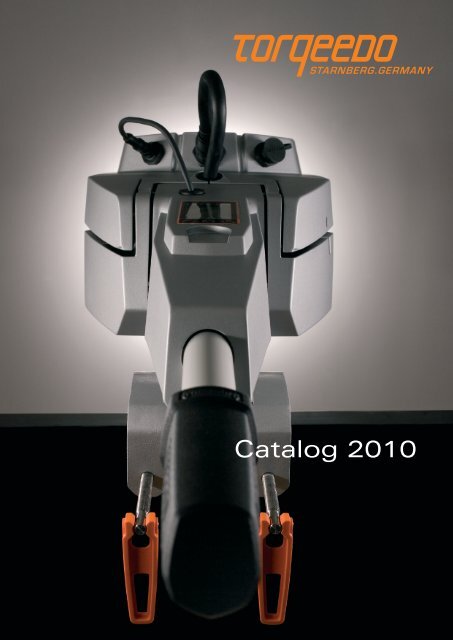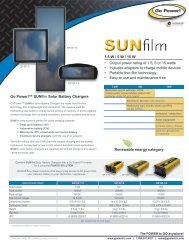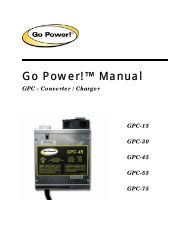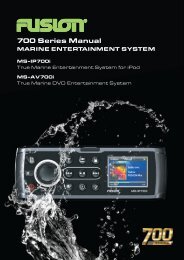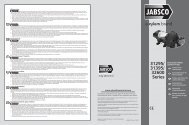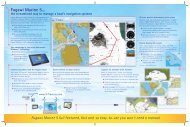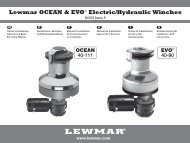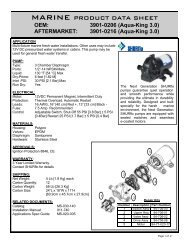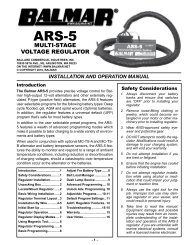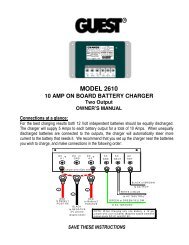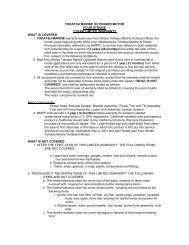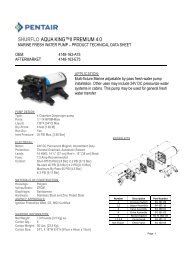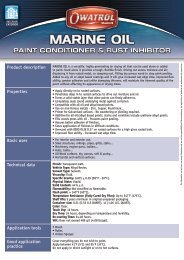Catalog 2010 - aqua services
Catalog 2010 - aqua services
Catalog 2010 - aqua services
Create successful ePaper yourself
Turn your PDF publications into a flip-book with our unique Google optimized e-Paper software.
<strong>Catalog</strong> <strong>2010</strong>
There are 2 simple principles behindany Torqeedo product:Superior technology and revolutionary benefit.Unrivalled technologyRecent developments in various fields of technology such aselectronics, material, and battery technology, have providedgreat potential for improving electric drives:• Commutation, or the current flow through the motor coils,which turns a motor, can be controlled by small, extremelyefficient electronic systems. This means mechanical contacts(brushes) are no longer necessary and gives us a newscope in motor design.• Rare earth magnets demonstrate much greater fieldstrength than traditional hexaferrite magnets and havebecome more affordable for use in the leisure industry.• Lithium-battery technology is continually expanding intomany aspects of today’s technology.Torqeedo is the first and so far the only company in the marineindustry that fully exploits the potential of these new technologiesin the development of a new generation of motors:high-tech, powerful, lightweight and clean.Unrivalled efficiencyWhy doesn‘t everybody use electric propulsion?It is not due to the motors: electric motors are superior overinternal combustion motors in every power class: they aresmaller, lighter, cheaper to produce and easier to maintain.It is due to battery technology: gasoline has 600 times the energydensity compared to a standard lead-gel or AGM battery.And even compared to latest lithium-battery technology theenergy density of gasoline is 100 times superior.So the question for electric propulsion is: how much propulsivepower do you get from a limited supply of batteryenergy?Torqeedo outboards run for up to 16 nautical miles on theenergy equivalent to 0.7 oz. of gasoline. In other words:our motors run for more than 3,000 miles on the energyequivalent to 1 gallon of gasoline.Currently, no one in the industry even comes close to thisperformance.<strong>Catalog</strong> <strong>2010</strong>
What is ecologically right can be economicallyright as well. Oh, and at higher comfort ofcourse.There are plenty of situations in which you can‘t avoid pollution.Running a small outboard is definitely no longer one ofthem.You can improve your ecological footprint without losingperformance and at greater comfort. And in the long run, it iseven cheaper than running a gasoline outboard. Too good tobe true?At Torqeedo we see it as our mission to offer cutting edgetechnology products that combine performance, responsibility,comfort and economical advantage.ContentsPropulsive power and overall efficiency Page 4Torqeedo technologies Page 6Ultralight 402 Page 8Travel 503/1003 NEW Page 10Travel 401/801 Page 12Cruise 2.0 (tiller control) Page 14Cruise 2.0 R/4.0 R Page 16Power 26-77 Page 18CIGS Solar Charger 62 W Page 20AGM batteries Page 21Technical data Page 22Ordering information Page 23You do have an alternative.<strong>Catalog</strong> <strong>2010</strong>
Propulsive power and overall efficiencyWhat you should know about the performanceof a boat driveIn commercial shipbuilding, the performance of a motor hasbeen measured for almost 100 years by how much power itactually delivers for propelling the vessel. This power is calledpropulsive power. It is physically defined as thrust actingon the vessel times speed, and can be expressed in watts orhorsepower.Also for recreational boating, propulsive power is the mostmeaningful performance indicator, as it measures the poweractually delivered to move the boat. Yet, you won‘t find figuresfor propulsive power in catalogs from other manufacturers ofelectric or gas outboards. Instead, you will find other figuresthat are less informative and don‘t allow to compare differentmotor types:• Typically, electric outboard manufacturers specify theirinput power in watts. This is an important indicator ofconsumption, but doesn‘t state how much of the powerconsumed is supplied to the boat. Describing a motorby input power alone is about as useful as measuring theengine performance of a car by its fuel consumption.• Electric trolling motor suppliers provide power ratings interms of static thrust, typically specified in pounds. Staticthrust describes the ability of a motor to move a boat fromspeed zero to an infinitely slow moving speed. Taken inisolation, static thrust is unsuitable as a measure of thepower of an outboard. As described above, the propulsivepower of a motor is defined physically as thrust times speed,so when the speed is zero, the propulsive power is alsozero. From our perspective, focusing on static thrust data asperformance indicators disguises the comparison of electricmotors versus horsepower ratings of gas outboards.• Manufacturers of internal combustion outboards do not statethe propulsive power of their motors either. Instead they givethe shaft power measured at the propeller shaft. Lossesdue to heat, incomplete combustion, friction etc.have already been accounted for at this point. However, theshaft power does not account for propeller losses, which canvary between 30% and 78% for different motor types. Therefore,shaft power is only, to a very restricted degree, usefulfor comparing different drive types.Just like manufacturers in commercial shipbuilding, atTorqeedo, we always go by the propulsive power of ouroutboards, i.e. the power actually delivered to the boat afterdeduction of all losses, including propeller losses. There aretwo reasons. First, it creates transparency so we can compareour motors properly with combustion outboards, which havesignificantly higher losses in the propeller. Second, measuringpropulsive power is the only way to ensure that we producethe world‘s most efficient outboards.Another important index apart from propulsive power isoverall efficiency. It describes the efficiency with which adrive system converts the supplied energy into propulsivepower, and is calculated from the relation between input powerconsumed and propulsive power. For internal combustion outboards,overall efficiency is interesting; for electric outboards,overall efficiency is key: As batteries have only a small fractionof the energy density compared to gas, the battery capacity isalmost always the limiting factor for an electric motor.Efficient use of the battery supply is decisive for how muchpower and range an electric drive can get out of a battery bank.Double overall efficiency means double range or higher speed.Typically, electric trolling motors have overall efficiency rates ofaround 20%. That means 80% of the input power is lost in themotor, cables and propeller. Very expensive, heavy and powerfulelectric drive systems that use conventional technologycome with overall efficiency rates of 30-35%. Torqeedo drivesgive you efficiency rates between 44% and 51%, making themtoday‘s leading technology. Internal combustion outboards areespecially inefficient, particularly in displacement travel.In this area more than 80% of the energy stored in the gasnever reaches the shaft, but is lost in the engine. Of this remainingshaft power, another 75% then gets lost in the propellerwhich results in an overall efficiency rate for internal combustionoutboards of approximately 5%. In other words, as muchas 95% of the energy contained in the gas is not converted intopropulsion, but lost to inefficiency.Our specifications of propulsive power and overall efficiencyrates have been confirmed not only in tests by independentpublications, but also by a certified test institute in a towingtank test.<strong>Catalog</strong> <strong>2010</strong>
Performance indicators of boat drivesElectric drivecomponentsBatteryCable Motor Gear PropellerInternal combustiondrive componentsFuel tankEngine Gear PropellerInput powerPower spec. of electricoutboards (losses notconsidered)Shaft powerPower spec. of gasoutboards (propellerlosses not considered)Propulsive powerPower spec. ofTorqeedo & commercialshipbuilding (all lossesconsidered)Overall efficiencyRelation of propulsive power to input powerPropulsive power and overall efficiency rates of various outboardsOverall efficiency in percent504030Torqeedo Cruise 2.0Torqeedo Travel 1003Torqeedo Travel 801Torqeedo Cruise 4.0 RPowerful electric outboards atexpensive prices36-48 VTorqeedo has by far the highestoverall efficiency rates on themarket.<strong>2010</strong>Gas outboard2.3 hpTrolling motors12-24 V50-80 lbs static thrustGas outboard6 hp0 500 1000 1500 2000Propulsive power in watts<strong>Catalog</strong> <strong>2010</strong>
Torqeedo TechnologySuperior technology for superior productsTorqeedo motors define new standards of efficiency and performanceper weight and volume. This is the result of carefuland uncompromising optimization of the individual componentsand their interaction combined with the very latest technologyin this performance class.Brushless electronic commutation:In conventional motors, the alternating field necessary fordriving the electric motor is provided by friction contactscommonly known as brushes.Torqeedo motors generate thealternating field contact-free via an electronic digital circuit. It isintegrated in the drive system and regulates the motor 35,000times per second. The advantages of this method are significant.The caster angle of the alternating field is better adjustedto the load and speed, making it more efficient. Additionally,there are no brush losses and the motors are maintenancefree.Outrunner design:In conventional electric motors, the rotor is located inside andsurrounded by the stator. The magnets are on the inside andthe coils that generate the alternating field are on the outside.Consequently, the magnetic field where the torque is generatedlies relatively far inside so that this design only produces a lowtorque. Torqeedo uses outrunners which have the coils arrangedinternally and the magnets are on the outside. With thisdesign, the field where the torque is generated can be arrangedfurther to the outside of the motor. This provides additionalleverage and produces a higher torque. Additionally, the areacovered by the magnets is greater on the outside, which resultsin even more torque.Rare-earth magnets:Torqeedo uses rare-earth magnets instead of the usual hexaferritemagnets. They have six times the field strength, whichmeans they deliver six times the torque.<strong>Catalog</strong> <strong>2010</strong>
Conventional propeller optimization:Generally, propellers with a large diameter and high pitch,which turn slowly in water, have the highest degree of efficiency.This is because a large propeller diameter results in ahigh propellant flow, while a high propeller pitch has a positiveeffect on the additional speed induced by the propeller. Incontrast, increasing rotational speed of the propeller leadsto decreasing efficiencies. As a result of their exceptionallyhigh torque, Torqeedo motors are able to drive highly efficientpropellers. In other words, they can rotate large propellers withhigh pitches relatively slowly in the water.Multidimensional propeller optimization:Most propellers used in outboard motors today are basedon a series of tests carried out in the 1940‘s to 1960‘s in theWageningen test facilities in the Netherlands and by the USNavy. The results are reflected in general design principles andapplied by rule of thumb. However, for some years now, largemodern ships have been fitted with propellers designed accordingto a multidimensional optimization calculation. Unlikestandard propellers, they feature pitches and cambers that arenot (almost) constant over all the propeller segments. Instead,pitch and camber are optimized on the basis of a vortex gridcalculation method and a stepwise optimization over manythousand iterations for each propeller segment. With theseadditional design scopes, Variable-Pitch-Variable-Camber-Propellersachieve additional speed induced by the propeller at topefficiency.Lithium-manganese battery technology:Lithium-based battery systems are by far the most powerfulenergy carriers currently available. Their special feature is theirhigh energy density giving them the capability of storing largerquantities of energy than other batteries. In addition, lithiumbatteries can withstand high current, resulting in the abilityto deliver their capacity even under high loads. Both of theseproperties are very significant for applications in boat drives.Among the various types of lithium batteries, lithium-manganeseis one of the safest compounds. The lithium battery-compositionand the battery packaging in safety cells are importantfeatures, as safety is almost as important for lithium batteriesas it is when handling gasoline.<strong>Catalog</strong> <strong>2010</strong>
Torqeedo Ultralight 402The kayak motorThe ultimate tool for kayak fishermen– or any paddler who wants to keepmoving while taking a rest.This is how we define superior technologyfor kayakers:• Weight of 15 lbs, that is of courseincluding the battery• Motor power equivalent to 1 HPgasoline outboard• Top speed above 6 mph, faster thanany trolling motor on the market• Range at slow speed (e.g. 2.5 mph)up to 19 miles• Fully waterproof system4• GPS based calculation of remainingrange• Mountable to most rigid hull kayaksIf you find anything in the world thateven comes close, let us know.6171 hp28,8 V (integrated)515.4 lbs2-yearlimitedwarranty231 Mounting ball attaches onto the topof the kayak. Ball-and-socket jointadapts to different kayak shapes.Only the small mounting ball isfixed permanently to the boat, themotor with all the other parts canbe easily removed when not needed.2 Extremely high-efficient drive train,performance comparable with 1 hpgas outboard.3 Auto kick-up feature to protect fromgrounding.4 Attachment point for a line to manuallytilt the motor.5 Attachment point for the “reversedrive” line (only necessary to reverse).6 Connection to kayak steering / steeringlock mechanism.7 Lithium-manganese high-performance batterywith integrated GPS-receiver.8 Remote throttle control with magnetic on/off key and information display (for photo,see page 9, bottom).9 The gauge on the remote throttle displays:battery charge status, remaining range atcurrent speed, speed over ground and currentpower consumption in watts.DetailsMounting: Can be mounted on most rigid-hull kayaks with stainless steel cavity dowel pins. Steering: Steering can be locked, after which kayak is steeredwith the paddle or the rudder. This results in a larger radius of turn. Alternatively, the motor can be connected to the rudder or the steering system of theboat, which makes it very maneuverable (e.g. for fi shing). Watertightness: All motor components are watertight, protected against complete immersion.Safety: The motor shuts off when the magnetic key on the remote throttle control is removed. Therefore, for safety reasons, the magnetic key should beattached to the wrist or the life vest. If the kayak capsizes, the motor shuts off automatically to avoid possible injury. Battery charge time: When fullydischarged, the charge time with the charger supplied is approximately 8 hours. Lithium-manganese battery life expectancy: Charge cycles are not themain factor affecting the service life of the lithium-manganese battery. The battery does not have a memory-effect. Generally, a loss of capacity of 4% peryear can be assumed. Ageing is accelerated if the battery is exposed to high temperatures for long periods and if it is stored fully charged for long periods.Therefore, the battery can be used in very hot conditions, but should be removed from the sun and stored in a cool place when not used. If it is stored for alonger period of time, its charge status should be about 50%. If these instructions are followed, your battery will have a life expectancy of some 6-10 years.Integrated battery specifications: The integrated battery has a capacity of 230 Wh, i.e. 8 Ah at 28.8 V.For technical data and ordering information, turn to pages 22/23 <strong>Catalog</strong> <strong>2010</strong>
8In cooperation with Hobie, we have adaptedthe Ultralight for the use with Hobie kayaks.The result is called Hobie eVolve: a kayakmotor combining the performance of theUltralight with plug & play installation forHobie kayaks.Just drop the eVolve into your Mirage welland turn your kayak into a compact electriccraft. Or mount it to the Twist and Stowrudder for a quick conversion to a hybridkayak…allowing you to pedal and use theelectric motor at the same time to extendyour range. Contact your Hobie dealer fordetails.Remote throttle informationdisplay (9)Battery charge statusRemaining rangePowered bySpeed over groundInput powerUltralight 402 with integrated battery (28.8 V / 8 Ah)Fishing kayak (Hobie Mirage Revolution), 13.5 ft, 58 lbsUltralight 402 with integrated battery (28.8 V / 8 Ah)Touring kayak (Prijon Prilite T470), 15.4 ft, 51 lbsSpeedin mphRangein milesRun timein hoursSpeedin mphRangein milesRun timein hoursSlow speed 2.6 15.6 6:00Half throttle 3.7 11.1 3:00Full throttle 5.8 3.5 0:36Slow speed 2.6 18.7 7:12Half throttle 3.9 11.7 3:00Full throttle 6.1 4.1 0:42Included in deliveryAccessoriesLithium-batteryRemote throttle controlBattery chargerSpare batterySpare propeller<strong>Catalog</strong> <strong>2010</strong>
Torqeedo TravelNEW 503 /1003 modelsSmarter, stronger, tougher.The perfect outboard for tenders, dinghiesand daysailers has become even better.1/897For many of our customers, the Travel is the definitive Torqeedooutboard. While its lightness, strength and efficiency were loved byall, we were frequently asked to come up with a non-foldable, morerugged version. This is what we have done. And while we were at it,we have equipped it with more power, even higher efficiency, morebattery capacity, and our onboard-computer including GPSand real-time range calculation.If you are looking for a high-end solution forsmall outboards that is even cheaper than a regular gasoline outboardin the long run (taking into account service/winterization cost) yoursearch is over.256Travel 503Travel 10031.5 hp3.0 hp4Travel 503Travel 100329.6 V (integrated battery)29.6 V (integrated battery)3Travel 503Travel 100328.0 lbs (S)/ 29.3 lbs (L)29.5 lbs (S)/ 30.8 lbs (L)2-yearlimitedwarranty1 Integrated GPS and information system:provides precise real-time informationon battery charge status, remainingrange at current speed, speed overground and power consumption (GPSreceiver located in the battery, informationdisplay located in the tiller).2 Improved mechanical stability, ruggednessand suitability for salt water use.3 20% higher power and approx. 10%higher efficiency, noiseless design.4 Corrosion-free design, does notrequire a sacrificial anode5 Auto-kickup feature in case ofgrounding6 30% higher battery capacity (Travel1003 model)7 All models can be solar-chargedduring operation.8 Audible alarm warns when batterycharge status reaches 30%9 Fully waterproof design, IP 67 (allcomponents can be submersed for1 hour at 3 ft below surface withoutany harm).DetailsWhich Travel motor for which boat? The Travel 503 and 1003 models are both suitable for inflatables, small boats and sail boats. We recommend the Travel401 for sail boats up to a weight of 1,500 lbs, and the Travel 1003 up to a weight of 1.5 tons. Both models consume the same level of energy at the samespeed. The stronger Travel 1003 has 30% higher battery capacity and therefore superior range. Both models are available in long and short shaft versions.Battery charge time: The battery recharge time from empty to full ranges between some 5 hours (Travel 503) and 7 hours (Travel 1003).Lithium-manganese battery life expectancy: Charge cycles are not the main factor affecting the service life of the lithium-manganese battery. The batterydoes not have a memory-effect. Generally, a loss of capacity of 4% per year can be assumed. Ageing is accelerated if the battery is exposed to high temperaturesfor long periods and if it is stored fully charged for long periods. Therefore, the battery can be used in very hot conditions, but should be removedfrom the sun and stored in a cool place when not used. If it is stored for a longer period of time, its charge status should be about 50%. If these instructionsare followed, your battery will have a life expectancy of some 6-10 years. Integrated battery specifications: The battery of the Travel motors have acapacity of 300 Wh (Travel 503) and 400 Wh (Travel 1003). The batteries are rated 10 Ah @ 29.6 V (Travel 503) and 13 Ah @ 29.6 V (Travel 1003).Charging the Travel battery from solar and from the on-board power supply: The battery can be solar charged during use. It comes with a chargeconnector that accepts solar chargers with a voltage between 24 V and 60 V and a charging current of 4 Amps max. To charge the battery from an on-boardpower supply, you will need an inverter that converts the on-board voltage to a value between 100 and 240 V (standard power outlet voltage, country-specificvoltages may vary). The charger provided in the supply package connects to the inverter. High-efficiency inverters are available on the market at veryaffordable prices. Watertightness: All motor components are watertight, protected against complete immersion. Safety: The motor shuts off when themagnetic key on the remote throttle control is removed. Therefore, for safety reasons, the magnetic key should be attached to the wrist or the life vest.10<strong>Catalog</strong> <strong>2010</strong>
Available March<strong>2010</strong>1Tiller informationdisplayBattery charge statusRemaining rangeSpeed over groundInput powerTravel 503 with integrated battery (29.6 V / 10 Ah)Inflatable, dinghy, sailboat up to 1,500 lbsTravel 1003 with integrated battery (29.6 V / 13 Ah)Inflatable, dinghy, sailboat or daysailer up to 1.5 tonsSpeedin knotsRangein nmRun timein hoursSpeedin knotsRangein nmRun timein hoursSlow speed 1.5-2.0 9.0-12.0 6:00Half throttle 2.5-3.0 5.0-6.0 2:00Full throttle 3.6-4.0 2.2-2.5 0:40Slow speed 1.5-2.0 12.0-16.0 8:00Half throttle 2.5-3.0 6.5-7.8 2:40Full throttle 4.5-5.0 2.0-2.2 0:26AccessoriesLithium-manganesebattery 300 WhLithium-manganesebattery 400 WhSpare propellerTravel 503Spare propellerTravel 1003CIGS Solar Charger62 W<strong>Catalog</strong> <strong>2010</strong> 11
Torqeedo Travel401/ 801 modelsFoldable, compact, light andstrong. The classic Torqeedooutboard.The Travel has won numerous accoladesand innovation awards fromaround the globe. With its integratedlithium-manganese battery, its lowweight, high power and efficiency, itis a great motor for tenders, dinghiesand daysailers up to 1.5 tons.And when it comes to transport, andspace-saving storage it is clearlyin a class of its own.Travel 401Travel 8011 hp2 hpTravel 401Travel 80114.8 V (integrated battery)29.6 V (integrated battery)Travel 401Travel 80125.1 lbs (S)/ 26.4 lbs (L)25.6 lbs (S)/ 26.9 lbs (L)2-yearlimitedwarrantyTestsieger10 / 2006Motoren < 1 kWDetailsWhich Travel motor for which boat? The Travel 401 and 801 models are both suitable for inflatables, small boats and sail boats. We recommend the Travel401 for sail boats up to a weight of 1,500 lbs, and the Travel 801 up to a weight of 1.5 tons. Both models are equipped with the same battery capacity andconsume the same level of energy at the same speed. With the stronger Travel 801 you have the option to use more power and achieve higher speeds, whichwill empty the battery more quickly. Both models are available in long and short shaft versions. Battery charge time: The battery recharge time fromempty to full ranges between some 5 hours (Travel 801) and 10 hours (Travel 401). Lithium-manganese battery life expectancy: Charge cycles are notthe main factor affecting the service life of the lithium-manganese battery. The battery does not have a memory-effect. Generally, a loss of capacity of 4% peryear can be assumed. Ageing is accelerated if the battery is exposed to high temperatures for long periods and if it is stored fully charged for long periods.Therefore, the battery can be used in very hot conditions, but should be removed from the sun and stored in a cool place when not used. If it is stored for alonger period of time, its charge status should be about 50%. If these instructions are followed, your battery will have a life expectancy of some 6-10 years.Integrated battery specifications: The battery of the Travel motors have a capacity of 300 Wh. The batteries are rated 20 Ah @ 14.8 V (Travel 401) and 10Ah @ 29.6 V (Travel 801). Charging the Travel battery from the on-board power supply: To charge the battery from an on-board power supply, youwill need an inverter that converts the on-board voltage to a value Wasserdichter between 100 and Packsack 240 V (standard power outlet voltage, country-specific voltages mayvary). The charger provided in the supply package connects to the inverter. High-efficiency inverters are available on the market at very affordable prices.Downward-compatible: The Travel can also run on lead batteries. Using the battery adapter cable set (available as an additional accessory), the motor canbe connected to conventional lead-acid, gel or AGM batteries. In this case, the Travel 401 needs a battery voltage of 12 V, and the Travel 801 a battery voltageof 24 V. For technical data and ordering information, turn to pages 22/2312<strong>Catalog</strong> <strong>2010</strong>
Travel 401 with integrated battery (14.8 V / 10 Ah)Inflatable, dinghy, sailboat up to 1,500 lbsTravel 801 with integrated battery (29.6 V / 10 Ah)Inflatable, dinghy, sailboat or daysailer up to 1.5 tonsSpeedin knotsRangein nmRun timein hoursSpeedin knotsRangein nmRun timein hoursSlow speed 1.8-2.2 10.8-13.2 6:00Half throttle 2.7-2.9 5.4-5.8 2:00Full throttle 3.6-3.7 3.0-3.1 0:50Slow speed 1.5-2.2 9.0-13.2 6:00Half throttle 2.4-3.2 2.4-3.2 1:00Full throttle 4.3-4.6 1.9-2.0 0:26AccessoriesSpare battery Charger for spare battery Tiller extension Spare propeller Battery adapter cable set<strong>Catalog</strong> <strong>2010</strong> 13
Torqeedo Cruise 2.0with tiller controlPrimary power at affordable prices12If you‘re looking for a powerful electric outboard motor, you have threeoptions. You can compromise on power and purchase a cheap, less powerfultrolling motor. Apart from its lower strength, it will have an overall efficiency rateof some 20% (i.e. 80% of the battery capacity is not converted into propulsivepower but is lost instead).Alternatively, you can purchase a rather expensive, very heavy motor from asmall, exclusive outboard builder. These motors usually have an overall efficiencyrange of 30-35%.Or you can purchase a Torqeedo. It‘s light, immensely powerful, and comes withan efficiency rating of more than 50%, which makes it clearly the high-end solutionon the market period. In addition, due to our industrial approach to electric outboards,it is also affordably priced.The Cruise 2.0 is a 24-volt motor that has the propulsive power of a 5 hp gasoutboard and the thrust of a 6 hp gas outboard. The <strong>2010</strong> models feature a newimproved driveline with improved longevity, higher efficiency and less noise.345 - 6 hp24 V40.8 lbs (S) / 41.9 lbs (L)52-yearlimitedwarranty1 Angle-adjustable telescopic tiller forstepless forward/reverse drive.2 Voltage indicator, provides informationto estimate current chargestatus of connected batteries.3 Transom bracket with gas-springsupportedtilt/trim mechanism.4 Hydrodynamically optimized shaft.5 High-efficiency drive train convertsbattery energy into propulsive powerwith unparalleled efficiency.6 American Wire Gauge 3 cable set for connectionof Cruise 2.0 with 24 V battery bank, includinghigh-current plugs for easy installation, aswell as main switch and fuse as suggested byinternational technical safety guidelines. (forphoto, see page 15, bottom).Test winner10 / 2006Outboards > 1 kWDetailsBattery supply: The Cruise 2.0 requires a battery voltage of 24 V. We recommend a battery supply of two batteries, each with a capacity of at least 180 Ah.Lead-based batteries are not resistant to high current, i.e. the capacities indicated on the casing are not available when the batteries are to be fully dischargedin a short time (e.g. 1 or 2 hours). For this reason, you should allow for sufficient reserves. Alternatively, the Cruise 2.0 can also be run with at least onelithium-manganese battery from the Torqeedo Power series. Connection to remote throttle/steering: No longer available with this model. For thisapplication, we developed our new models, Cruise 2.0 R and 4.0 R. See details on pages 16/17. Saltwater use: The Cruise R models shown on pages 16/17are better suited for the use in salt water than this tiller version. They are also waterproof IP 67. Using the Cruise 2.0 tiller version in saltwater does requireprotection of the contacts and protection from complete submersion. For technical data and ordering information, turn to pages 22/2314 <strong>Catalog</strong> <strong>2010</strong>
The power of an electric drive system is typically limited bythe available battery supply: Electric motors are superior tointernal combustion engines in all aspects and in every powerclass (they are typically smaller, lighter, easier produce, easierto maintain etc.). However, batteries have a much lowerenergy density than gas. Therefore, especially when installingpowerful electric outboards, paying attention to the overallefficiency of the outboard is imperative – because it determineshow much range and power you receive from a givenbattery supply, which is typically limited by weight and volumeconstraints. Currently no outboard motor comes even close toa Torqeedo in this respect.Cruise 2.0 (with 2 x 12 V / 200 Ah lead batteries)Rowing boat, 20 ft, 1,650 lbsSpeedin knotsRangein nmRun timein hoursSlow speed 1.5 165.0 110:00Half throttle 2.6 42.9 16:30Full throttle 5.5 11.0 2:00Cruise 2.0 (with 2 x 12 V / 200 Ah lead batteries)30 square-metre skerry cruiser, 40 ft, 2.6 tonsSpeedin knotsRangein nmRun timein hoursSlow speed 1.5 165.0 110:00Half throttle 2.6 42.9 16:30Full throttle 4.9 9.8 2:00Included in deliveryAccessoriesCable set (6)Tiller extensionSpare propellerCable set extensionTorqeedo Power<strong>Catalog</strong> <strong>2010</strong> 15
Torqeedo Cruise 2.0 R / 4.0 R23The standard for powerful electric outboards1The Cruise R models come with a whole set of superlatives:As all Torqeedo outboards, they are by far the highest efficiency outboards in theirpower class. This feature is especially important for strong outboards, if you wantto avoid carrying excessive amounts of batteries. With an overall efficiency of 51%they transform over half of the energy supplied by the batteries into propulsivepower (measured after all losses, including propeller losses). As far as we know,this value is substantially higher compared to any other manufacturer on the market.The models are waterproof (IP 67), protected against submersion for at least 1 hour.They are equipped with our onboard computer and GPS, calculating the remainingrange based on power consumption, speed and reading the attached external batteries.They offer by far the best power-to-weight ratio among all electric outboards.And they certainly offer the best price-performance ratio of the industry in thispower class.764Cruise 2.0 RCruise 4.0 R5 - 6 hp8 - 9.9 hpRemote throttle informationdisplay (8)5Cruise 2.0 RCruise 4.0 R24 V48 VBattery charge statusRemaining rangeCruise 2.0 RCruise 4.0 R37.5 lbs (S) / 38.6 lbs (L)39.7 lbs (S) / 40.8 lbs (L)Speed over ground2-yearlimitedwarrantyInput power1 Connection for standard remote steeringcontrol.2 Integrated GPS receiver supplies data toon-board information system.3 Handle for tilting and trimming the motor.4 Thread for locking the motor steering ina defined position (e.g. for sailing boatsthat steer with the rudder).5 High-efficiency drive train convertsbattery energy into propulsive powerwith unparalleled efficiency.6 Transom bracket with tilt/trimmechanism.7 Tilt/lock mechanism. Setting “Tilt/Autokick-up” enables tilting and activatesgrounding protection (full-throttlereverse drive not possible). “Lock”setting enables full-throttle reversedrive (grounding protection disabled,tilting not possible).8 The gauge on the remote throttledisplays: battery charge status, remainingrange at current speed, speed overground and current power consumptionin watts.Included in deliveryAmerican Wire Gauge 3 cable set forconnection of Cruise R models withbattery bank, including high-currentplugs for easy installation, as well asmain switch and fuse as suggested byinternational technical safety guidelines.Remote throttle control withmagnetic on/off pin and informationdisplay. Link arm and guide tube.DetailsBattery supply: The Cruise 2.0 R requires a battery voltage of 24 V, the Cruise 4.0 R requires 48 V. We recommend a battery supply of batteries with at least180 Ah capacity each. Lead-based batteries are not resistant to high current, i.e. the capacities indicated on the casing are not available when the batteriesare to be fully discharged in a short time (e.g. 1 or 2 hours). For this reason, you should allow for sufficient reserves. Alternatively, the Cruise 2.0 R can alsobe run with at least one lithium-manganese battery from the Torqeedo Power series. The Cruise 4.0 R can be run with two batteries from the Torqeedo Powerseries. Connection to remote throttle/steering: The motor is designed for connection with a standard remote steering system (e.g. Teleflex). Includedin the delivery are a guide tube which runs through the transom bracket as well as a link arm. Also, included is a remote throttle control with integratedon-board information display. Tiller control: No longer available for this model. See details on our tiller version of the Cruise 2.0 above. On-board informationsystem: The computer integrated in the remote throttle control analyses and combines information received from the motor, batteries and GPS. Whilethe motor and GPS data are very accurate, the battery information is based on estimates which can vary according to the connected battery type, age andcapacity in each case. The indications of battery charge status and remaining range are therefore estimates that are less accurate than those of the Ultralightand Travel models. Licence friendly: The Cruise 4.0 R has a shaft performance of 3.5 kW or 4.7 hp. This puts it under the regulation threshold for manyinland lakes (e.g. 5 hp). Yet, due to the super efficient propeller it has the propulsive power of an 8 hp gas outboard (relating to boats in displacement drive).Its static thrust is as strong as a 9.9 hp internal combustion engine (See pages 4/5 for details on performance indicators). For technical data and orderinginformation, turn to pages 22/2316 <strong>Catalog</strong> <strong>2010</strong>
The Cruise 4.0 R pushes a well-stocked 24 ftpontoon boat with 25“ pontoons and seven peopleaboard at more than 6 mph. Cruise 4.0 twininstallations can run pontoon boats at up to12 mph.On light boats, Cruise 4.0 R models with lithiumbatteriesand high-speed propellers run at 11-15mph. Twin installations of Cruise 4.0 R motorscan put boats into plane also with lead-gel orAGM batteries.Cruise 2.0 R (with 2 x 12 V / 200 Ah lead batteries)30 square-metre skerry cruiser, 40 ft, 2.6 tonsSpeedin knotsRangein nmRun timein hoursSlow speed 1.5 165.0 110:00Half throttle 2.7 44.6 16:30Full throttle 5.0 10.0 2:00Cruise 4.0 R (with 4 x 12 V / 200 Ah lead batteries)Pontoon boat, 24 ft, well stockedSpeedin mphRangein milesRun timein hoursSlow speed 4.1 41.0 10:00Half throttle 5.3 21.2 4:00Full throttle 6.1 12.2 2:00AccessoriesHigh-speed propellerSpare propellerTorqeedo PowerCharger<strong>Catalog</strong> <strong>2010</strong> 17
Torqeedo Power 26-77More power, lighter weight – Torqeedolithium-manganese batteries for the highestdemandsLithium batteries represent the leading battery technology onthe market today. The advantages they offer over conventionalbatteries are dramatic: They have a much higher energydensity, they easily deliver high current and they also featureoutstanding cyclic stability and therefore a long service life.Lithium batteries provide various options for use on boats.On the one hand, you can save around 70% battery weight.Alternatively you can increase the capacity of your batterybank substantially and drive more powerful electric outboardsor simply have more energy at your disposal on theship. While batteries from the Torqeedo Power series reflectlatest battery technology, they’ve also been proven on themarket for several years.1132.0 kWh (25.9 V, 77 Ah)241.9 lbs2-yearlimitedwarranty1 Solid copper connections with M19threads for optimum electric conduction.2 Two plus and two minus poles forconveniently connecting severalbatteries. For larger battery banks,provision is made for connectingbatteries with industrial-standardcopper rails.3 RS485 bus interface for reading batteryinformation for battery bank monitor.Data transferred includes e.g. capacity,charge status, voltage and internaltemperature.4 Control panel with indicator of chargestatus.DetailsCapacity: 2 kWh Charge: 77 Ah Rated voltage: 25.9 Ah Final voltage: 29.05 V Final discharge voltage: 21.0 V Electrochemical type: Lithium-manganeseCells: 18650 safety cells, quantity 336 Fuses: The battery cells in Torqeedo Power batteries can produce very high currents. For safetyreasons, they are equipped with standard 120 A internal fuses. The maximum power delivery per battery is approximately 3.1 kW. Higher power deliveriesrequire either more batteries in series or Torqeedo must modify the fuses (then up to 10 kW can be delivered per battery). Connecting batteries (paralleland serial): Up to 40 batteries per bank. Installation of banks consisting of 2 batteries or more only after instruction by Torqeedo. Serial connections of morethan 2 batteries may be performed only by personnel trained and authorized explicitly by Torqeedo. Operating temperature: -20° C to +65° C Chargingtemperature: 0° C to +45° C Weight: 42 lbs Dimensions in inches: 20 x 7 x 9. For ordering information, turn to page 2318 <strong>Catalog</strong> <strong>2010</strong>
Safety is a the primary design principle forTorqeedo lithium-batteries. Three aspects areimportant:Chemical battery composition: Batteries arefrequently described non-specifically as lithium-ion batteries.This is a collective term that groups together various typesof battery chemistries. Some of these, e.g. lithium-cobalt orlithium-cobalt mixed with nickel, fail in appropriate safety testsand are fire and explosion hazards. This is why they shouldnot be used in larger batteries. Other battery compositionssuch as lithium-iron-phosphate or the lithium-manganese typeused by Torqeedo are intrinsically safe, even in a case whenthe safety electronics fail, or if the batteries are mechanicallydamaged.Battery casing: If there is an internal short-circuit, explosivegases can develop inside a lithium battery. For lithiumbatteries in polymer packaging, this can result in pressurebeing build up, which can ultimately burst the casing.The explosive gas then released is a serious hazard. For thisreason, Torqeedo does not employ polymer packaging butmetal safety cells, which feature a safety vent. If internalpressure builds up, the metal cylinder expands at a pre-definedpoint and mechanically separates the cathode from theanode. This deactivates the battery, explosive gas will notbe released.Fuses: Unlike lead batteries, lithium batteries can deliververy high currents without problems. In case of a short-circuit,this is an undesirable side effect. Therefore, Torqeedobatteries have internal 120 A fuses so that any incorrectinstallation without external fuses will not cause severeunwanted side effects.Energy densities: Comparison of lead-gel batteries andlithium-manganese batteries of the same weight (42 lbs)Available capacityin WhLithium battery with longer servicelife due to better cycle stabilityCapacity in % ofrated capacity2,0001,500Power 26-77(Lithium manganese)Energy shownalmost fully availablefor utilisation806050% depth of dischargeLithium-manganese battery80% depth of discharge50% depth of dischargeQuality lead-gel battery1,000Weight saving withlithium batteries >70%4080% depth of discharge500Quality gel battery with the same weight(12 V, 55 Ah). Broken line indicates availablecapacity if >500 cycles are requiredfrom the battery (only 50% of capacityavailable for utilisation for most makes)0 500 1,000 1,500 2,000 2,500 3,000Dischargein W200 500 1,000 1,500 2,000Numberof cyclesAccessoriesChargerBattery bank monitor<strong>Catalog</strong> <strong>2010</strong> 19
CIGS Solar Charger 62 WIndependence made simpleFor many years running your boat from solar energy was a cumbersome task.It generally involved large solar panels, which had to be permanently installed.These times are over. New CIGS solar cells (Copper Indium GalliumDiselenide) offer up to twice the efficiency compared to conventionalthin film solar cells. Combined with the low energy consumptionof the highly efficient Torqeedo outboards, running your boatfrom solar power has become very simple.From a surface area of less than 11 square feet, the CIGS solar charger providessufficient energy to charge the lithium-batteries of the Travel 503/1003 series quickerthan the chargers that come with the products. What a convenient and clean wayto charge the batteries of your tender, sailboat or fishing boat. If you use the CIGSsolar charger while running your boat, you can run between 1.3 and 2.2 knots fromthe energy provided by the charger (results vary depending on the boat).Yet, if you do not need the CIGS Solar Charger, it folds into a handy format of 37 x32 cm and can be transported and stored easily. It weighs a mere 1.6 kg and connectswith the Travel 503/1003 models as well as other 24 V devices.Needs to be stored dryTravel 503/1003 modelsUnfolded_52.5 x 30.0 x 0.1 inchesFolded_14.5 x 8.5 x 1.5 inches55 oz.2-yearlimitedwarrantyDetailsOutput power: Maximum 62 watts; under typical sun exposure in North America and Europe output powers of 40-45 watts can be expected. Cell type:CIGS (Copper Indium Gallium Diselenide) Efficiency: Cell efficiency 9.8%, module efficiency 7.5% Voltage: open circuit voltage 56 V, designed to charge24 V systems. Charging options: The batteries of the Travel 503/1003 models can be solar charged while not in use, as well as during operation. Chargingtime from 0% to 100% charge: The 300 Wh battery of the Travel 503/1003 series will charge in approx. 8 hours; the 400 Wh battery of the Travel 503/1003series will charge in approx. 10 hours of sunlight. Compatibility/plugs: works with other 24 V electric devices; comes with extension cable and 2.5 mm IDbarrel plug; will fit onto Travel 503/1003 models. Weatherproofness: The CIGS solar cells are laminated onto a Rip-Stop Nylon. They are weatherproof andmeet military specifications (Mil Std 810). After use, they need to be stored in a dry condition. Light-soaking: If not used for a longer period of time, CIGScells may require some 3-4 hours of light-exposure to reach their full output power again. Power guarantee: Limited warranty of2 years refers to 80% of specified power.20<strong>Catalog</strong> <strong>2010</strong>
Torqeedo on AGM BatteriesIf you do not want to go for lithium-batteries, we recommendyou go for OptimaFor economical reasons, many of our customers use Torqeedo outboards of theCruise series together with lead-based battery systems (lead-acid, lead-gel, AGM).As we want our customers to enjoy clean, quiet and powerful electric boating withthe range they desire, we have conducted a series of tests to determine, whichbatteries are best suited for a marine propulsion application. Based on our tests,we can recommend Optima BlueTop batteries of the DC series:Higher effectively available capacity:The nominal battery capacity of any lead-based battery is ratedbased on a slow rate of discharge, typically over 20 hours.If the battery is emptied within 2 or 3 hours only a fraction ofthis nominal capacity is effectively available to the user. ForOptima batteries, this effect is significantly lower than for allother batteries tested. Therefore, among various makes of batterieswith the same capacity rating (in Ah) the Optima batterywill have the highest effectively available capacity.Best deep discharge characteristics:If you deep-discharge a battery completely, many batterieswill only work for a few cycles before losing a substantialshare of their capacity. Optima batteries will keep around 70%of their original capacity even after 300 cycles at 90% depthof discharge. This is as impressive as it is important: In anelectric propulsion application, deep discharges occur fairlyfrequently.Smaller and lighter battery supply:Due to the factors mentioned above, boaters can run theirelectric outboard from a smaller and lighter battery bank ifthey use Optima batteries, while achieving the same speedand range a somewhat larger and heavier different batterybank would have offered.Economical solution:While Optima batteries require a higher initial purchaseprice than many other makes, they are among the mosteconomical solutions on the market, taking into account theeffectively available capacity and the longer lifetime.Battery performance in marine propulsion applications- Optima batteries with more effective capacity at comparable Ah-ratings- Lower weight and volume of battery bank- Very economical in the long run due to better longevityBattery A AGM 95 9.120 2.702 0:41 3:04 568Battery B AGM 90 8.640 2.864 0:43 3:19 541Battery C AGM 90 8.640 4.048 1:01 4:35 504Battery D AGM 90 8.640 4.701 1:11 5:23 487Battery E Gel 80 7.680 3.340 0:50 4:00 497Battery F Gel 80 7.680 3.293 0:49 3:59 400OPTIMA DC AGM 75 7.200 5.422 1:22 6:13 467Battery Technology Nominalcapacityin AhNominal capacityof battery bankconsisting of8 batteries in kWh*Effectivelyavailable batterybank capacity @4,000 W consumptionand if batterybank shall lastfor 300 cycles (inkWh)**Run-time@ 4,000watts inhrsRun-time@ 1,000watts inhrsWeight ofbattery banksin lbs* Capacity of batteries in Wh is calculated as Voltage (V) times Charge (Ah). The capacity of the battery bank is calculated as capacity per battery (in Wh) times number of batteries.** Taking into account different high current capabilities and different deep charge characteristics of the various batteries. The deep discharge characteristics are considered underthe prerequisite that 300 cycles must only lead to 30% loss of the original capacity. Under this prerequisite, Optima batteries can be discharged 90% for 300 times. Other batteriescan only be discharged 65%, 50% or even only 35% (starter batteries) for 300 times while keeping 70% of their original capacity.<strong>Catalog</strong> <strong>2010</strong>21
Technical data and ordering informationTechnical dataInput power inwattsPropulsive powerin wattsComparablegas outboards (propul-sivepower)Comparable gasoutboards (thrust)Maximum overallefficiency in%Ultralight402Travel 401S/LTravel 801S/LTravel 503S/LTravel1003S/LCruise 2.0S/LCruise 2.0RS/RL400 400 800 500 1,000 2,000 2,000 4,000180 175 350 220 480 900 1,020 2,0401 hp 1 hp 2 hp 1.5 hp 3 hp 5 hp 5 hp 8 hpCruise 4.0RS/RL2 hp 2 hp 4 hp 2 hp 4 hp 6 hp 6 hp 9.9 hp45 44 44 44 48 45 51 51Static thrust in lbs* 33 40 68 40 68 121 110 214Integrated batteryRated voltagein voltsFinal voltagein volts230 WhLIMA300 WhLIMATotal weight in lbs 15.4 25.1 (S) /26.4 (L)Weight of motorwithout battery inlbsWeight of integratedbattery in lbsShaft length ininchesPropeller dimensionsin inchesPropeller speedin rpmControlSteeringTilting device300 WhLIMA300 WhLIMA400 WhLIMAno no no28.8 14.8 29.6 29.6 29.6 24 24 4833.2 16.8 33.6 33.6 33.6 - - -9.9 17.4 (S) /18.7 (L)25.6 (S) /26.9 (L)17.9 (S) /19.2 (L)28.0 (S) /29.3 (L)19.6 (S) /20.9 (L)29.5 (S) /30.8 (L)19.6 (S) /20.9 (L)40.8 (S) /41.9 (L)37.5 (S) /38.6 (L)- - -5.5 7.7 7.7 8.4 9.9 - - -17.7 23 (S) /28 (L)23 (S) /28 (L)23 (S) /28 (L)23 (S) /28 (L)24.6 (S) /29.3 (L)24.6 (S) /29.3 (L)39.7 (S) /40.8 (L)24.6 (S) /29.3 (L)8 x 8 12 x 10 12 x 10 12 x 10 11.5 x 8.1 12 x 10 12 x 10 12 x 101,200 700 700 700 1,200 1,300 1,300 1,300RemotethrottlecontrolProvision forconnectionto kayakrudder:lockableManual withgroundingprotectionTiller control Tiller control Tiller control Tiller control Tiller control Remotethrottlecontrol180°lockableTrim device - Manual,3-stepStepless forward/reverse drive180°lockable360°lockableManual Manual Manual withgroundingprotectionManual,3-stepManual,4-step360°lockableManual withgroundingprotectionManual,4-step360°lockableGas pressurespringassistedManual,5-stepProvision forconnectionto standardremotesteering,lockableManual withgroundingprotectionManual,4-stepYes Yes Yes Yes Yes Yes Yes YesRemotethrottlecontrolProvision forconnectionto standardremotesteering,lockableManual withgroundingprotectionManual,4-step*Torqeedo static thrust measurement is based on globally valid ISO standards. Static thrust figures for conventional trolling motors aremeasured digressively, which results in higher values. In order to compare Torqeedo static thrusts data with conventional trolling motors,add approximately 50% to the Torqeedo static thrust values.22 <strong>Catalog</strong> <strong>2010</strong>
Ordering informationItemNo.Product Description MSRPin US$Power Propeller / accessoires Cruise Travel Ultralight1401-00 Ultralight 402 Kayak motor, 1 HP equivalent with integrated LIMA high-performance battery, charger, remote throttle control,GPS-based range calculator, information display, magnetic on/off pin and travel bag1411-00 Spare batteryUltralight 4021412-00 Charger for sparebattery Ultralight 4021,799.00LIMA high-performance battery with integrated GPS receiver, 230 Wh, 28.8 V, 8 Ah 599.0040 watt charger (20 V, 2 A) for charging Ultralight 402 batteries, for power connection with 100-240 Vand 50-60 Hz1120-00 Travel 503 S High-efficiency outboard with integrated 300 Wh LIMA high-performance battery, 1.5 HP equivalent,with GPS-based range calculation, information display, charger included, short shaft version1121-00 Travel 503 L As item 1120-00, but with long shaft 1,599.001122-00 Travel 1003 S High-efficiency outboard with integrated 400 Wh LIMA high-performance battery, 3 HP equivalent, withGPS-based range calculation, information display, charger included, short shaft version1123-00 Travel 1003 L As item 1122-00, but with long shaft 1,899.001124-00 Spare battery 300 Wh forTravel 503/1003 models1125-00 Spare battery 400 Wh forTravel 503/1003 models1127-00 Charger for spare batteryTravel 503/1003 models69.991,599.001,899.00LIMA high-performance battery with integrated GPS receiver, 300 Wh, 29.6 V, 10 Ah 599.00LIMA high-performance battery with integrated GPS receiver, 400 Wh, 29.6 V, 14 Ah 699.0040 watt charger (12 V, 3.3 A) for charging 300 Wh and 400 Wh batteries, for power connection to 100-240 Vand 50-60 Hz1107-00 Travel 401 S Foldable outboard, 1 HP equivalent, with integrated LIMA high-performance battery, charger and travel bag,short shaft version1108-00 Travel 401 L As item 1107-00, but with long shaft 1,499.001109-00 Travel 801 S Foldable outboard, 2 HP equivalent, with integrated LIMA high-performance battery, charger and travel bag,short shaft version1110-00 Travel 801 L As item 1109-00, but with long shaft 1,699.001111-00 Spare battery Travel 401 LIMA high-performance battery with integrated charge status display, 300 Wh, 14.8 V, 20 Ah 599.001112-00 Spare battery Travel 801 LIMA high-performance battery with integrated charge status display, 300 Wh, 29.6 V, 10 Ah 599.001113-00 Charger for spare batteryTravel 4011114-00 Charger for spare batteryTravel 80169.991,499.001,699.0040 watt charger (20 V, 2 A) for charging Travel 401 batteries, for power connection to 100-240 V and 50-60 Hz 69.9980 watt charger (40 V, 2 A) for charging Travel 801 batteries, for power connection to 100-240 V and 50-60 Hz 69.991115-00 Battery adapter cable set Adapter for connection of Travel 401/801 models to standard lead-, gel- or AGM-batteries with 12 V (Travel 401)or 24 V (Travel 801), incl. 10 ft connection cable with fuse and short connection cable for linking 2 batteries1205-00 Cruise 2.0 S High-efficiency and extremely powerful 24 V motor, thrust comparable to 6 hp gas outboard, incl. 10 ft cableset, AWG 3, with fuse and main switch, tiller operated, short shaft version1206-00 Cruise 2.0 L As item 1205-00, but with long shaft 2,749.001209-00 Cruise 2.0 RS High-efficiency and extremely powerful 24 V motor, thrust comparable to 6 hp gas outboard, incl. remotethrottle control, magnetic on/off key, GPS-based range calculation, information display, 10 ft cable set AWG 3,with fuse, main switch and link arm to connect to standard steering system1210-00 Cruise 2.0 RL As item 1209-00, but with long shaft 3,249.001211-00 Cruise 4.0 RS High-efficiency and extremely powerful 48 V motor, thrust comparable to 9.9 hp gas outboard, incl. remotethrottle control, magnetic on/off key, GPS-based range calculation, information display, 10 ft cable set AWG 3,with fuse, main switch and link arm to connect to standard steering system1212-00 Cruise 4.0 RL As item 1211-00, but with long shaft 3,749.001204-00 Cable set extension Cruisemodels199.002,699.003,199.003,699.00Extension for Cruise cable set, 6 ft long, with high-current plugs 99.001129-00 CIGS Solar Charger 62 W High-efficiency foldable and flexible CIGS solar module, plugs simply into the integrated LIMA batteries ofTravel models 503/1003 and charges also other 24 V devices1901-00 Spare prop. Travel 401, 801,BaseTravel, Cruise tiller withserial number 5,0001916-00 Highspeed prop. Cruise R,Cruise tiller serial nr. >5,00012” x 10” variable-pitch-variable-camber (VPVC) propeller developed especially for the torque characteristicand performance range of Torqeedo-motors. Made of impact-resistant glass-fibre reinforced PBT (polybutyleneterephthalate), complete with nuts, disc springs and shear pinAs item 1901-00, but with 8“ x 8“ 79.99As item 1901-00 79.99As item 1901-00, but with 12“ x 12“ 499.001917-00 Spare propeller Travel 1003 As item 1901-00, but with 11.5“ x 8.1“ 79.991906-00 Tiller extension Longer tiller handle, 24 inches long, suitable for use on Travel 401/801 models, BaseTravel andCruise tiller models2101-00 Torqeedo Power 26-77 LIMA high-performance battery, capacity 1,994 Wh, rated voltage 25.9 V, charge 77 Ah, weight 42 lbs,connection to other batteries only after consultation with Torqeedo2205-00 Charger 350 W for TorqeedoPower 26-77Charger with lithium charging characteristics (CC-CV charging), charge power 350 W, i.e. Torqeedo Power 26-77fully charged in less than 6 hours.999.0079.9939.99N/AN/A2302-00 Cruise-Power adapter Adapter to connect Cruise model cable sets with Torqeedo Power 26-77 N/A<strong>Catalog</strong> <strong>2010</strong> 23
Europe and internationalTorqeedo GmbHPetersbrunner Str. 3a82319 StarnbergGermanyT +49-8151-268 67-0F +49-8151-268 67-19Productdesign & Layout www.schlagheck-design.de Photography www.sandraeckhardt.deNorth AmericaTorqeedo Inc.171 Erick Street, Unit A-1Crystal Lake, IL 60014USAT +1- 815 - 444- 88 06F +1- 815 - 444- 88 07Your Torqeedo retailerwww.torqeedo.comThis catalog is printed on chlorine-free paper sourcedfrom sustainable forestry. Goods are delivered exclusivelyaccording to our Terms of Sale and Delivery according to thecurrently valid General Business Conditions of Torqeedo.We reserve the right to make formal changes and changesto the price of our products.


